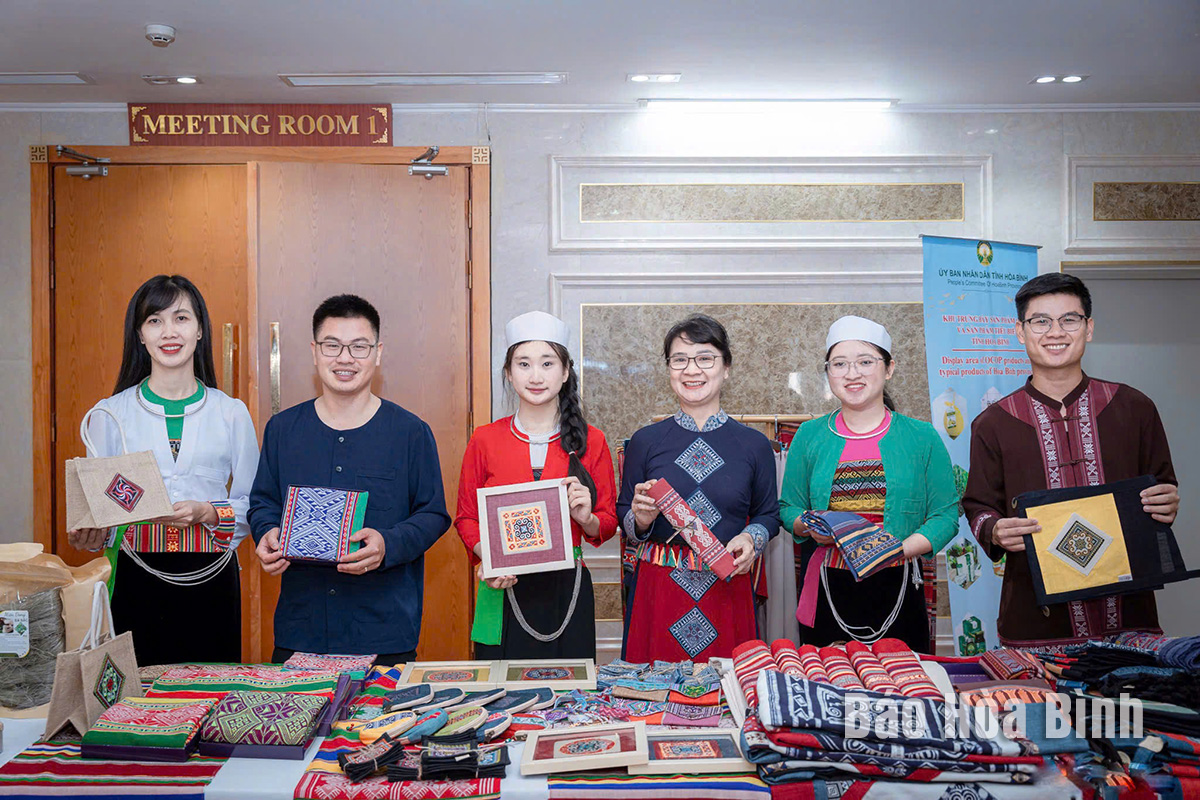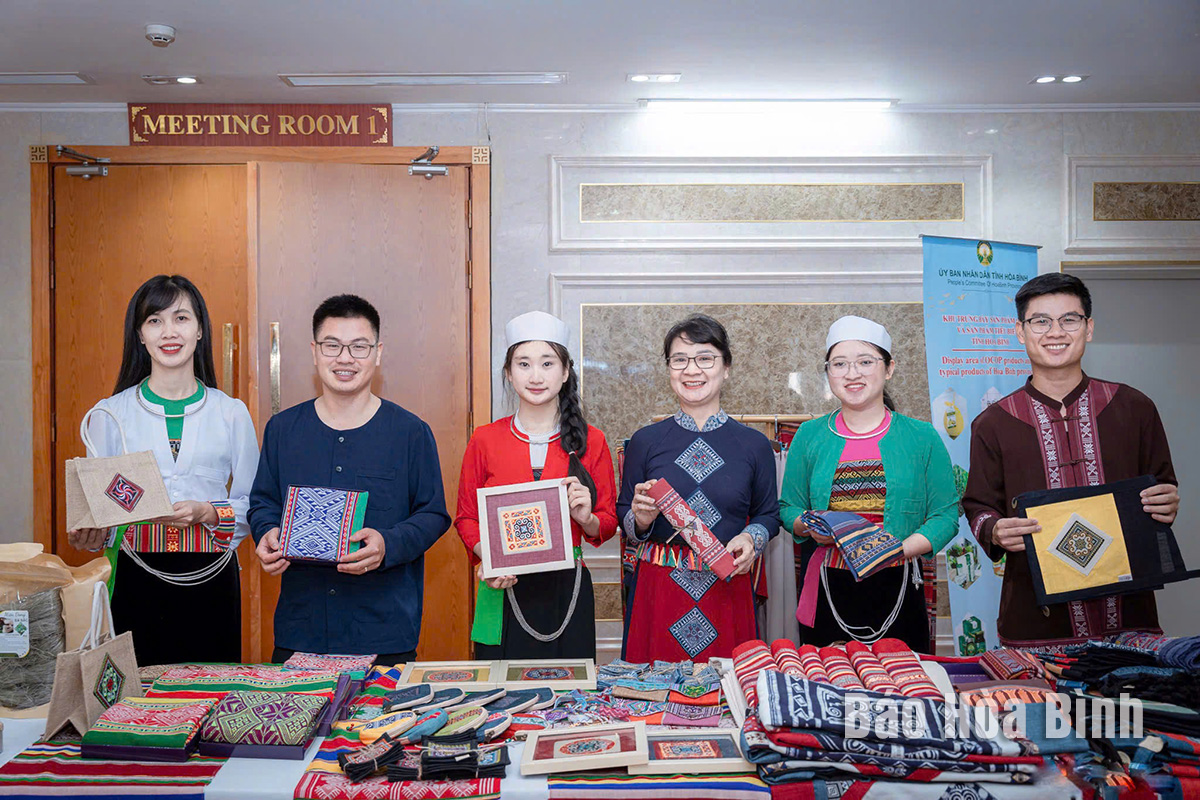
In the context of globalisation and deeper integration, preserving and promoting the national cultural identity is of utmost importance. Aware of their pioneering and proactive role on all fronts, over the years, the youth organisations at all levels in Hoa Binh province have implemented various concrete and practical activities to preserve and promote the cultural identities of ethnic groups in the locality.
The youth club for preserving and promoting ethnic cultural identity of the province, in collaboration with Hoa Dat Muong store (Hoa Binh city), introduces outstanding local cultural products at the "Meet India" programme in 2024 organised by the provincial People's Committee.
Hoa Binh is home to various ethnic groups, namely Muong, Kinh, Thai, Dao, Tay, and Mong. Each has its own customs, beliefs, and heritage values of literature and arts, language, writing and folk knowledge, and unique traditional costumes. The province is also renowned for the world-famous Hoa Binh Civilization, the cradle of the ancient Vietnamese culture.
Over recent years, the province has paid attention to and directed the work of preserving and developing the culture of ethnic minorities.
However, in the era of Industry 4.0, there are numerous difficulties and challenges. Many cultural values of the Muong ethnic group and the "Hoa Binh Civilisation" face the serious risk of being lost.
Nguyen Van Doan, head of the youth club for preserving and promoting ethnic cultural identity of the province, stated that with their pioneering and proactive role, technology skills, and ability to access information, local young people and youth union members have effectively utilised digital platforms to spread and promote ethnic culture. Many have used social media platforms such as Zalo, TikTok, and Facebook to introduce their customs, traditions, and cultural heritage to a large audience both domestically and internationally. Notably, they have effectively used digital technology to showcase the beautiful landscapes and distinctive cultural features of the ethnic groups in the province to tourists.
In addition, local youths have pioneered in digital transformation, building and applying QR codes at historical and cultural relic sites to provide information about and automated interpretation of the province’s culture and tourism for residents and tourists.
Nguyen Duy Tu, Secretary of the provincial Ho Chi Minh Communist Youth Union, said that through practical actions, union members and youth in the province have consistently raised their awareness and sense of responsibility in preserving and promoting traditional cultural values. They have been the core force in efforts to preserve and promote ethnic cultural identity.
With an increasingly vibrant and widespread emulation movement aimed at building cultured residential areas and cultured families, Yen Thuy District has been making steady progress toward improving both the material and spiritual well-being of its people, while fostering a civilized, prosperous, beautiful, and progressive community.
Once lacking recreational spaces and community facilities, Residential Group 2 in Quynh Lam Ward (Hoa Binh City) has recently received attention for the construction of a new, spacious, and fully equipped cultural house. The project followed the model of state support combined with public contributions in both labor and funding.
The "All people unite to build cultural life" movement, which has been effectively integrated with Kim Boi district’s socio-economic development goals, is fostering a lively spirit of emulation across local residential areas, hamlets, villages, public agencies, and enterprises. In addition, through the initiative, traditional cultural values are being preserved and promoted, while community solidarity and mutual support in poverty reduction and economic development are being strengthened.
A working delegation of the Hoa Binh provincial People’s Committee led by its Permanent Vice Chairman Nguyen Van Toan on June 11 inspected the progress of a project to build the Mo Muong Cultural Heritage Conservation Space linked to tourism services in Hop Phong commune, Cao Phong district.
Born and growing in the heroic land of Muong Dong, Dinh Thi Kieu Dung, a resident in Bo town of Kim Boi district, in her childhood was nurtured by the sweet lullabies of her grandmother and mother. These melodies deeply imprinted on her soul, becoming an inseparable part of her love for her ethnic group's culture. For over 20 years, this love for her hometown has driven Dung to research, collect, and pass down the cultural values of the Muong people to future generations.
In the final days of May, the Ethnic Art Troupe of Hoa Binh Province organized performances to serve the people in remote, mountainous, and particularly disadvantaged areas within the province. These were not just ordinary artistic shows, but they were the meaningful journeys aimed at spreading cultural values, enhancing the spiritual life of the people and contributing to the preservation of ethnic minority cultural identities.



